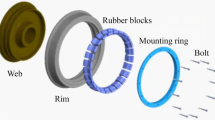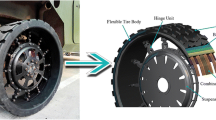Abstract
The effects of structural nonlinearity (including rubber material and contact boundary nonlinearities) and variable wheel/rail contact point on the dynamic characteristics of resilient wheels are studied to investigate the mechanical properties of these wheels. Primarily, static and dynamic tests are designed to determine the nonlinear constitutive relationship of rubber materials in resilient wheels, and the viscoelastic properties of rubber are discussed. On this basis, the mapping relationship between the elastic modulus and stiffness of rubber in a resilient wheel system is deduced, and the stiffness characteristics of viscoelastic rubber materials are determined. The dynamic models of four types of wheels namely, a solid wheel (SW), a resilient wheel that considers linear rubber (RWL), a resilient wheel that considers nonlinear rubber (RWNL), and a resilient wheel that considers nonlinear rubber and contact boundary (RWNC), are established on the basis of the Yeoh constitutive model for hyper-elastic materials. The changes in wheel/rail contact point and wheel/rail force during train running are obtained under long/short wave irregularity excitation by adopting an established vehicle–track coupled dynamic model. Then the nonlinear dynamic behavior of resilient wheels subjected to varying wheel/rail contact point and wheel/rail force is studied. Finally, the influences of rubber material parameters on the dynamic characteristics of resilient wheels are explored. Results show that the acceleration of a resilient wheel is effectively reduced compared with that of SW. Resilient wheel acceleration that considers variable wheel/rail contact point is larger than that without considering the change in wheel/rail contact point. The deformation rates of rubber subjected to variable and constant wheel/rail contact behavior are 7 and 10%, respectively, and the midpoint deformation of rubber is less than its endpoint deformation. Compared with that of SW, the acceleration of RWL is reduced by 10 and 17% respectively under variable and constant wheel/rail contact points, respectively. Meanwhile, the acceleration of RWNL is reduced by 9 and 7% compared with that of RWL. The influences of nonlinear material characteristics and contact boundary on the dynamic characteristics of resilient wheels are not evident. The major vibration frequencies of the four types of wheels are 3–5, 10, and 22 Hz. The vibration and deformation of resilient wheels increase with an increase in the hardness of rubber.























Similar content being viewed by others
Data availability
The data that support the findings of this study are available from the corresponding author upon reasonable request.
References
Bouvet P, V’meent N, Coblentz A et al. Optimization of resilient wheels for rolling noise control. J. Sound Vib. 1993(1): 253–260 (1996).
Bu, J.L., Huang, Y.J.: Design and calculation method of railway vehicle rubber elastic components. China Railway Publishing House, Beijing (2010). (in Chinese)
Cigada, A., Manzoni, S., Vanali, M.: Geometry effects on the vibro-acoustic behavior of railway resilient wheels. Vib. Control. 17(12), 1761 (2011)
Claus, H., Schiehlen, W.: Dynamic stability and random vibrations of rigid and elastic wheelsets. Nonlinear Dyn. 36(2–4), 299–311 (2004)
Cornelius, O.H., Jeremiah, G.M.: Compression tests and constitutive models for the slight compressibility of elastic rubber-like materials. Int. J. Eng. Sci. 47(11), 1232–1239 (2009)
Holger, C., Werner, S.: Dynamic stability and random vibrations of rigid and elastic wheelsets. Nonlinear Dyn. 36, 299–311 (2004)
Hou, C.L., Qi, Y., Wang, S., et al.: Stiffness characteristic analysis of rubber resilient wheel based on Mooney-Rivlin model and Yeoh model. Int. Combust. Engine Parts 11, 38–40 (2018) (in Chinese)
Le, Z., Bernd, M.: Simulation of stiffness analysis of rubber material applied in resilient wheel. PAMM 16(1), 251–252 (2016)
Li, S.L., Zhu, S.Y., Xu, Y.L., Chen, Z.W., Li, H.: Long-term condition assessment of suspenders under traffic loads based on structural monitoring system: Application to the Tsing Ma Bridge. Struct. Control. Health Monit. 19(1), 82–101 (2012)
Li, S.L., Wei, S.Y., Bao, Y.Q., Li, H.: Condition assessment of cables by pattern recognition of vehicle-induced cable tension ratio. Eng. Struct. 155, 1–15 (2018)
Major, M., Major, I.: Comparative analysis of stress in hyper–elastic Mooney-Rivlin and Zahorski, materials using Adina software. Trans. Všb-Techn. Univ. Ostrava Civil Eng. 15(2), 1–9 (2016)
Marckmann, G., Vgerron, E.: Comparison of hyper–elastic models for rubber-like materials. Rubber Chem. Technol. 79(5), 835–858 (2006)
Polach, O.: Characteristic parameters of nonlinear wheel/rail contact geometry. Veh. Syst. Dyn. 48(Suppl), 19–36 (2010)
Remington, P.J.: Wheel/rail rolling noise. Part H Theoretical Analysis. Aeoust. Soe. Am, 81(6):1805–1823 (1987).
Rivlin, R. S., Saunders, D. W.: Large elastic deformations of isotropic materials VII. Experiments on the deformation of rubber. Philos. Trans. Roy. Soc. Lond. A243: 251–288 (1951).
Rodrigo, T., Sakdirat, K.: Life cycle cost evaluation of noise and vibration control methods at urban railway turnouts. Environments 3(4), 34–34 (2016)
Sato. Study on high-frequency vibration in track operation with high-speed trains. Quarterly Report of RTRI, 18(3), 109–114 (1997).
Sebesan, I.: IOP Conf. Ser: Mater. Sci. Eng 2018(01), 324–324 (2018)
Steinmann, P., Hossain, M., Possart, G.: Hyper–elastic models for rubber-like materials: consistent tangent operators and suitability for Treloar’s data. Arch. Appl. Mech. 82(9), 1183–1217 (2012)
Thompson, D.J., Gautiter, P.E.: Review of research into wheel/rail rolling noise reduction. Proc. Institution Mech. Eng. Part f: J. Rail Rapid Transit 220(4), 385–408 (2006)
Thompson, D.J., Jones, C.J.C.: A review of the modeling of wheel/rail noise generation. J. Sound Vib. 231(3), 519–536 (2000)
Tian, J.H., Wang, K.: The strength analysis of new W-shape resilient wheel under different working conditions. Adv. Eng. Res. 9(1), 123–126 (2017)
Wen, J., Li, F., Yang, Y., Ding, J.J.: Parameters optimization and track adaptation research of urban vehicle resilient wheels. Electr. Drive Locomotives 244(3), 74–77 (2015) (in Chinese)
Xing, L.L., Li, F., Fu, Z.B.: Analysis of critical velocity and curving performance of vehicle with resilient wheels. Electr. Locomotives Mass Transit Veh. 35(01), 25–28 (2012) (in Chinese)
Yang, Y., Ding, J.J, Li, F.: Longitudinal vibration of a resilient wheel under the adhesion limit. Proc. Inst. Mech. Eng. Part F: J. Rail Rapid Transit, 233(4) (2019).
Yeoh, O.H.: Characterization of elastic properties of carbon-black-filled rubber vulcanizates. Rubber Chem. Technol. 63(5), 792–805 (1990)
Yeoh, O.H.: Some forms of the strain energy function for rubber. Rubber Chem. Technol. 65(5), 754–771 (1993)
Zhai, W.M.: Vehicle–track coupled dynamics. Science Press, Beijing (2020)
Zima, R., Manasek, P.: Rubber resilient wheels cut urban rail noise. Int. Railw. J. 3(4), 387–405 (2003)
Funding
This work was supported by National Natural Science Foundation of China [52008067], the Department of Science and Technology of Sichuan Province [2021YFG0211], the Natural Science Foundation of Chongqing [CSTB2022NSCQ-MSX1193], the Chongqing Construction Science and Technology Project [CS2020-4-6], the Open Research Fund of the State Key Laboratory of Mountain Bridge and Tunnel Engineering [SKLBT-19-002].
Author information
Authors and Affiliations
Corresponding authors
Ethics declarations
Conflict of interest
The author declares no conflict of interest in preparing this article.
Additional information
Publisher's Note
Springer Nature remains neutral with regard to jurisdictional claims in published maps and institutional affiliations.
Rights and permissions
Springer Nature or its licensor (e.g. a society or other partner) holds exclusive rights to this article under a publishing agreement with the author(s) or other rightsholder(s); author self-archiving of the accepted manuscript version of this article is solely governed by the terms of such publishing agreement and applicable law.
About this article
Cite this article
Chen, Z., Pu, Q., Long, Q. et al. Mechanical characteristics of resilient wheels that consider structural nonlinearity and varying wheel/rail contact point. Int J Mech Mater Des 20, 15–33 (2024). https://doi.org/10.1007/s10999-023-09655-8
Received:
Accepted:
Published:
Issue Date:
DOI: https://doi.org/10.1007/s10999-023-09655-8




